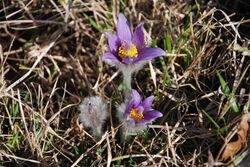Biology:Pulsatilla grandis
| Pulsatilla grandis | |
|---|---|

| |
| Pulsatilla grandis under Mt. Boč, Slovenia | |
| Scientific classification | |
| Kingdom: | Plantae |
| Clade: | Tracheophytes |
| Clade: | Angiosperms |
| Clade: | Eudicots |
| Order: | Ranunculales |
| Family: | Ranunculaceae |
| Genus: | Pulsatilla |
| Species: | P. grandis
|
| Binomial name | |
| Pulsatilla grandis (Wender., 1830)
| |
Pulsatilla grandis, the greater pasque flower, is a species of flowering plant in the genus Pulsatilla of the family Ranunculaceae. It is a perennial plant that grows on calcium-rich soil in dry grasslands, in rocky outcrops, and in pine and oak forests. It flowers from February to April, in the time of the Easter (which gives it its name), with intensively blue to violet flowers.[1] Its silk stalk is protected from the cold by velvety trichomes (hairs). Pulsatilla grandis is native to the countries of Central, Eastern and Southeastern Europe, and is particularly frequent in Hungary. In some of them, it is classed as threatened.
Slovenia
In Slovenia, Pulsatilla grandis (named velikonočnica, the Easter flower) is a rare and protected plant. It has four growing places in the country all of them are situated in the sub-Pannonian phytogeographical area in the northeastern part of Slovenia. The plant is the symbol of the Boč–Donatus Mountain Landscape Park. On a small rise near the Boč growing place, a stone sculpture of the flower, created by the sculptor Franc Tobias from Razvanje, has been put on display in the 2000s. Pulsatilla grandis is also depicted on the coat of arms of the Diocese of Celje.
References
External links
- Pulsatilla grandis: Species Range. Maps.iucnredlist.org.
Wikidata ☰ Q145399 entry
 |


